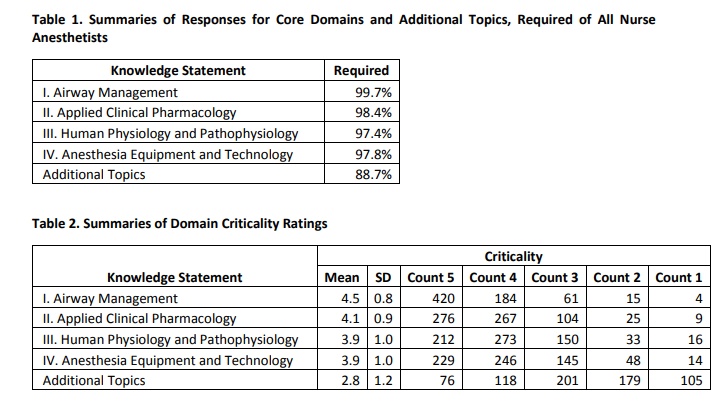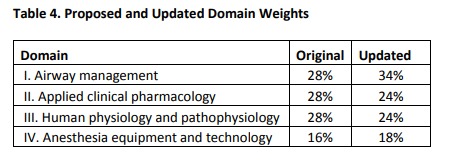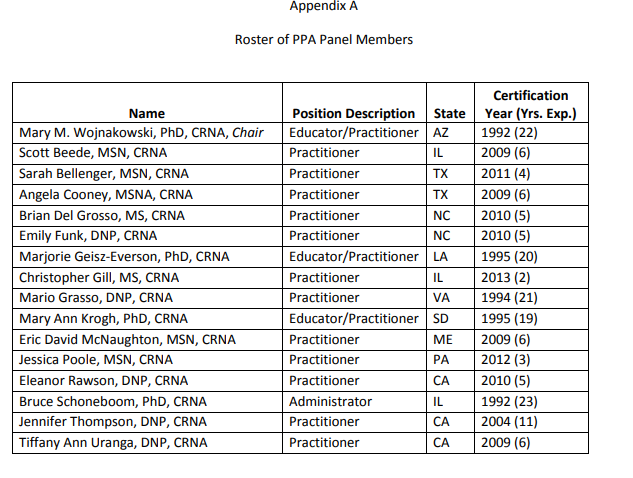CPC Examination Professional Practice Analysis
Executive Summary - 2015
The National Board of Certification and Recertification for Nurse Anesthetists (NBCRNA) is an autonomous body, with multidisciplinary and public representation, that is responsible for specifying the requirements for earning and maintaining the Certified Registered Nurse Anesthetist credential. In 2015,
the NBCRNA conducted a national professional practice analysis (PPA) study of the knowledge, skills, and abilities required of nurse anesthetists at the level of practice expected for continued professional certification. The purpose of the practice analysis was to define a logical, practice-related, and evidence based content framework to support the development of the examination component of NBCRNA’s Continued Professional Certification (CPC) Program.
Key to this effort, NBCRNA convened a panel of subject matter experts (SMEs, see Appendix A) in nurse anesthesia, who were representative of the profession with respect to geography (from across the United States) and practice setting among other demographic variables, and reflective of those nurse
anesthetists who would be participating in the CPC Program long-term. The PPA Panel was charged with analyzing the practice of nurse anesthesia at a level that is more advanced than that expected for initial certification, and to review, evaluate, and revise the knowledge elements included in the proposed CPC Examination (CPCE) content outline (originally published December 2014).
The practice analysis study consisted of the following four major phases:
1. Initial Development and Validation. The PPA panel reviewed and proposed revisions to the domains, tasks, knowledge, and skills specified in the proposed content outline for the CPCE. These revisions included the deletion and re-wording of some headings, and adding specificity for others. The goal of this stage was to further evaluate the knowledge essential to the proficient practice of nurse anesthesia by nurse anesthetists beyond the point of initial certification. After several small adjustments to the knowledge elements of the proposed content outline, the updated outline was converted into an online questionnaire format in order to collect validity ratings.
2. Pilot Survey. A sample of 60 individuals, including the PPA Panel, reviewed the online survey, which included as survey items the domains, tasks, knowledge, and skills, of the CPCE content outline, as well as questions pertaining to the domain weightings of the outline (test blueprint) and demographics relevant to the anesthesia profession. This pilot stage brought about refinements to the survey.
3. Validation Study. A random sample (N = 12,000) of nurse anesthetists was invited to review and validate the work of the PPA panel by completing the online survey. A qualified and representative sample of nurse anesthetists provided data in this phase. Of the 12,000 e-mail invitations, just over half (6,048, or 50.4%) of the recipients actually opened the e-mail, and 2,184 clicked the link to the survey. Of these, 726 provided valid, usable responses, completing at least half of the survey. With respect to the 6,048 people who opened and presumably read the e-mail invitation, the sample going forward to analysis represented a 12% response rate. The survey was open and available for responses from May 12 – June 8, 2015.
Respondents were asked to evaluate each knowledge element in the content outline, rating them using 5-point scales for criticality and frequency, as well as whether the knowledge element was required of a nurse anesthetist. Criticality was defined as the degree that inability to perform duties related to each knowledge element could be seen as causing harm to stakeholders. Frequency was defined as how often the nurse anesthetist performs duties that require proficiency in each of the knowledge elements.
On June 18-19, 2015, the CPC PPA Panel met in Chicago, IL, to review the results of the PPA survey and to make recommendations for the CPCE content outline. The majority of the meeting was devoted to reviewing summaries of ratings of the survey respondents and making decisions about what knowledge statements should be included in the CPCE content outline. Generally speaking, high levels of endorsement were observed on almost all elements of the CPCE content outline.
Tables 1-3 contain summaries of “required of nurse anesthetists,” criticality, and frequency ratings for the four core domains of the CPCE, as well as the “Additional Topics”. As can be seen in these summaries, there were high levels of endorsement across the four domains. While Tables 1-3 only summarize ratings for the primary domain headings, similar levels of support were observed for almost all knowledge elements in the outline.


Based on the ensuing discussion, and the generally high levels of endorsement on almost all elements of the CPCE content outline, only minor changes to the outline were recommended as a result of the review:
- Element “Laboratory and/or diagnostic studies” deleted from outline (subtopic under Domain 1, Airway Management)
- Element “Clinical indications, uses, interpretations, limitations of airway laboratory or diagnostic studies related to airway management” deleted from outline (tertiary topic under subtopic 1.E.)
- Element “Interpret laboratory and/or diagnostic studies” deleted from outline (subtopic under Domain 2, Applied Clinical Pharmacology)
- Element “Intraoperative monitoring techniques” retained, but moved up a level to II.C.
- Elements listed under “Additional topics” heading deleted
The rest of the knowledge statements on the outline were retained.
4. Development of Specifications for Assessment. A statistical analysis and subsequent review of the survey ratings of the respondent sample of nurse anesthetists formed the basis for a test blueprint for the CPCE. The test blueprint indicates relative emphasis that each domain will receive on the examination and translates into the number of questions an examinee will receive from each core domain. The domain percentages recommended by the PPA Panel were updated from the original proposed blueprint.

Conclusion
In September 2015, the NBCRNA Board reviewed the work of the PPA Panel and approved the modifications to the CPCE content outline, as well as the updated domain percentages. The full, updated content outline can be found here.
As the primary process for identifying the competency areas and knowledge needed for proficient performance in a profession, PPA studies offer a clear and useful basis for defining the essential components of credentialing programs, especially assessments. This is because PPA studies, as the most commonly applied and accepted validation strategy for establishing certification programs, provide the basis for content validity. Validation through systematic practice analysis studies helps to document that the competence to be inferred when a candidate has achieved a credential bears a sound link to the significant elements of practice that characterize the profession. This was the underlying intent of this study.
NBCRNA’s practice analysis study is an integral part of ensuring that the examination component of the CPC Program has practice-related validity and that the aspects of nurse anesthesia addressed by the program reflect the requirements of practice settings, patient groups, and conditions.

